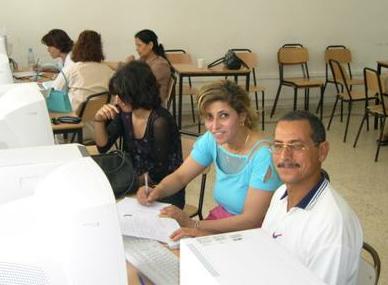
Return to CALL
resources main page | View Site Index |
Vance's: introduction /
CV in html /
CV
in pdf
Portals: Main Mahdia 2004 Workshops
page | Blog: http://vance2004tunisia.blogspot.com
| Buzznet: http://mahdi2004.buzznet.com |
YahooGroup: http://groups.yahoo.com/group/mahdia_2004
or http://tinyurl.com/5g7pb |
Photos:
Ofoto
pictures album | TVS: http://www.evt.edunet.tn/ |
Participant: Blogs and
Webpages
New Information Technologies
in ELT
IT Networks in ELT
Workshops presented by Vance
Stevens
Group 1 (week 1) July 19 - 24, 2004, in Mahdia, Tunisia
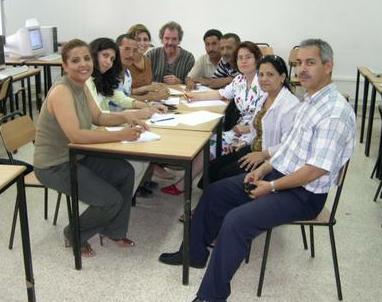
Henda, Nadia, Habib, Radhia, me, Adel, Mongi, Besma,
Dalel, Nasser
Workshop activities
for Week 1
Monday | Tuesday | Wednesday |
Thursday | Friday |
Saturday
Ofoto
pictures album | Pictures with linkable URLs from
Week 1
|
Monday July
19
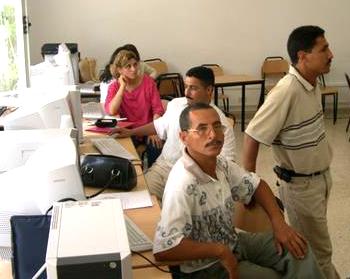
|
I arrived at 8:00 a.m. with Tunis embassy personnel whose job it
was to see that things went 'smoothly'. The good news was that we found the LAN
was Internet enabled and functioning, but that most of the sites I was counting
on using were blocked either by the Tunisian proxy (all of my
http://www.vancestevens.com, along
with anything from Geocities.com) or at the institute firewall. The firewall
was preventing all email access (no Yahoo.com, and along with that no
YahooGroups access). There was no access to Tapped In (no Java on the browsers,
so no java-based chats or interfaces, and when Java was downloaded, still no
chat connection). Of all the sites I had intended to use, I had access only to
Blogger and Buzznet. I retrenched accordingly and used
http://www.tinyurl.com to create URLs that
I could note on the blackboard so that students could access the sites
successfully.
- I started the sessions by introducing myself. I had my laptop
hooked into the LCD so I was able to show sites from my local files though
could not actually surf the Internet from my laptop.
- I ended with the portal site I had created (this one) and then
went into my planned activity, as follows:
.
|
- Principles of tutoring online, which apply? - In groups, explore
sites and compile lists of applicable principles, record URLs and other notes
in a text editor. The students did the search I suggested (I made a TinyURL out
of it so they could all reach the same Google search, third item down, at
LIBRARY: DELIVERING e-LEARNING Role and skills of the Online Tutor, at
http://www.e-learningcentre.co.uk/eclipse/Resources/teach.htm.
The students mostly stopped exploring at the first article: Be an Active and
Participative Instructor By Jennifer Hofmann.
http://www.learningcircuits.org/2003/dec2003/hofmann.htm.
This article reached the following conclusions about tutor-student environments
and these became our mantra for the rest of the day
- adequate student motivation
- opportunity for students to collaborate and interact
- a blend of delivery methods
- usable technology
- an active and participative instructor
- Everyone then started a blog at http://www.blogger.com. The idea was to
'transfer computer-based notes to your blogs for presentation to others (in
class and around the world)' but it was enough of an accomplishment that
everyone started one. I started one myself at
http://vance2004tunisia.blogspot.com
and I wrote down the blog addresses of everyone else in the group who created a
blog. I hyperlinked them and showed the class how to make hyperlinks in their
blogs. I emphasized that the most crucial advantage of web-based approaches to
tutoring was the ability to hyperlink creatively. Essential code to know for
this purpose is
<A HREF="html link goes here">Text to click
on goes here</A>
I thought the day ended well despite the many potential pitfalls. At the
end of the day one of the students requested more clarity in guidelines and
step-by-step instructions, and said I should 'check' that these steps were
followed, and I pointed out to her that she had succeeded in creating her blog
and that I had indeed 'checked' that all students had done so and made a list
at my own blog. Furthermore it should be obvious that given the situation on
the ground any advanced preparation I had made on this particular day would not
have been applicable, and that each day's activities would have to be planned
in response to what was available on site and to the needs of the workshop
participants which, as I had been told, I would know when I got there.
By the end of the morning, email service at Hotmail and Yahoo, and also
YahooGroups, were working and I was able to return that evening and prepare
materials via my blog. However, interaction with the concurrent teacher
training session in Maracaibo in which I had hoped to involve my trainees was
out of the question (no tapped in and no instant messagers). I was also up to
that point unable to get my laptop online at the institute, and Internet access
via my hotel had not materialized, so I had no access to FTP and was unable to
update this web page as I went. I fell back on my blog for planning and
organization http://vance2004tunisia.blogspot.com.
|
Tuesday July
20 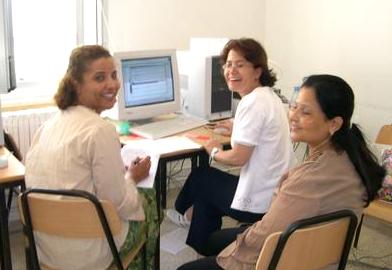 |
On this day we continued work on our blogs and started a
YahooGroup at http://groups.yahoo.com/group/mahdia_2004.
I showed students how to start the group and went through some of the features
of the site. Participants were challenged to:
- Obtain a Yahoo ID and password (if they didn't have one
already)
- Register for the group
- Send an introduction message
- Add links to their blogs to the Our Blogs folder of the Links
area (by end of day only 3 students had done both tasks)
Below is the information I placed in my blog to facilitate
formation of student enrollment in our YahooGroup. |
To enroll, you must be a Yahoo member (Sign up at
http://www.yahoo.com)
If you are a Yahoo
member, simply
- visit the YahooGroup website,
http://groups.yahoo.com/group/mahdia_2004
or
its Tiny URL: http://tinyurl.com/5g7pb
- click Join this Group
- enter your Yahoo name and ID
- Let Yahoo use your default profile and email address
- decide whether to accept the default email setting or ...
- receive an email each time someone posts to the group (default
setting)
- receive a bundle of emails each day (a digest of all emails
packaged in a single email )
- have NO mail delivered but still be able to read messages
whenever you like on the website
- Write in plain text the numbers and letters on the graphic that you
see (this is Yahoo's way of keeping spammers out by ensuring that a human is
signing up for this service)
- Submit the data
You can also subscribe by email:
mahdia_2004-subscribe@yahoogroups.com
(in that case you can receive email but you won't be able to utilize the Yahoo
Group web site features at http://groups.yahoo.com/group/mahdia_2004)
Once you've subscribed, do the following:
- Send a message to introduce yourself and check the web site for
earlier messages. Either
- When you can access the website as a member, add a link to your blog
by adding a bookmark to the Our Blogs folder under Links. Here are the steps:
- Log onto the website
- Click on Links in the column at left
- Browse to the 'Our Blogs' folder
- Enter your blog address. It should look like:
http://yoururlhere.blogspot.com
To find your blog URL,
log on to your account at http://www.blogger.com, and look it up under
Settings / Publishing
- use Edit to correct any errors
Workshop participants at this stage were taking little note of what I
was writing in my blog and expressed dissatisfaction that I had not brought
with me paper handouts. I on the other hand had not been shown facilities
whereby I could prepare such handouts. By the end of the week I had worked out
how to print to the printer in the server room, but it was not then possible to
have multiple photocopies made. On my Sunday day off I worked to attenuate this
problem for the next week's batch of participants.
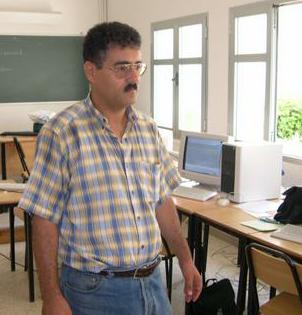 |
I made two very interesting discoveries today:
- I discovered that by going into the chat feature of YahooGroups
I got connected to the Yahoo Messenger network. I was able to download MSN
Messenger by end of day and get it working, but YM remained unresponsive.
- I discovered that my Geocities cites ARE available in Tunisia
and presumably in China ... through Google's cached pages facility. I was able
to pull up recent cached versions of my pages by elicting them in a Google
search and then clicking on 'cached' rather than the URL offered. The links,
even the internal ones, wouldn't necessarily work, but I was able to at least
get at my pages which contained other URLs I could follow, and thus retrieve
other cites whose URLs were otherwise unavailable to me. This was useful
because students were asking me about online resources, which are catalogued at
various places in my site stored at Geocities. I was now able to show them the
(cached) URLs.
|
Extensive listings of
tutor resources available on the Internet
I made links in my blog to an extensive set of tutor resource materials
at my ESL_Home website, using the Google cached URLs as indicated above. My
idea was that we should explore these sites and find ones that might help the
teachers in their tutoring work. The participants would record their findings
in their blogs.
In practice, the work on blogs at this stage was at a more basic
level. I felt the participants were going along at their own pace so I didn't
push my agenda. Also it turned out that there was a separate thread going on
in the workshop. The Tunisian trainer was having the students do a similar
project in the afternoons, and sometimes the students worked on these during my
sessions. The project involved locating resources on the Internet and
developing materials from these. When I saw this work taking place I tried to
get participants thinking about how they might use online spaces to share their
findings with others.
Some participants were expressing an interest in the logical next step:
getting their pictures on the Internet. That evening I updated my blog (this
portal page being still not available for upload) to include links to managing
blog templates and to learning more about hyperlinks and picture links from my
HTML tutorial at http://www.homestead.com/prosites-vstevens/files/pi/very_basics/starthere.htm
Again I thought the sessions went very well that day, with students
appearing to be enthusiastic about following wherever my guidance might take
them. That evening Dalel gave me a thorough overview of the TVS site and
explained how tutors would be using the forum and FAQ areas, and we agreed that
she would give her presentation to our participants next day so that they could
be put in the picture more regarding how this would work practically. We agreed
that she should start next morning on it and I would start with photos in blogs
after the break.
|
Wednesday July
21 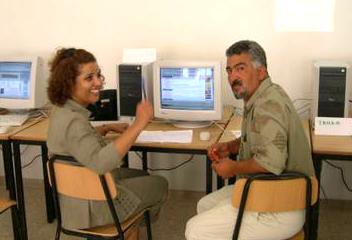 |
On this day I got my laptop connected to the LAN. I was still not
able to get my email or have FTP from behind the firewall, but I was able
browse from my computer and transfer files via various other protocols, and I
was able to reach Homestead and upload files to there from my computer. Some of
these files were picture files, so I was on my way to placing student pictures
on the web to give them URLs they could use as links in their blogs.
I also uploaded photos from my camera to
http://www.ofoto.com, which I am using to
take photos from my computer and put them on the Internet, where I can 'share'
my photo albums by having the site generate a URL where my photos can be
accessed. To do this ...
- I share my albums with my OWN email address
- I REMOVE the check box requiring my friends to sign in
- I send the URL I receive to others or post the URL in my blogs
and web pages
|
I found that the above steps could not be done from
behind the firewall at the Institute (clicking Submit has no effect) but I have
since discovered that to 'share' your photo albums, no need to go through these
steps. Simply open your album in your browser, copy its URL, and send that to
your friends. There is no need for them to sign in to see the photos.
Our photo albums are here:
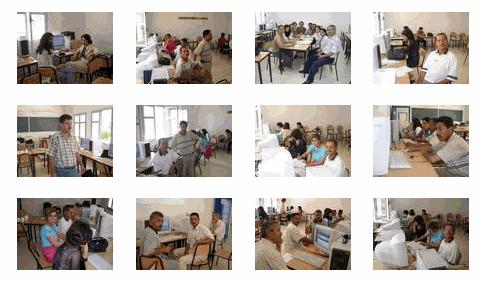
Later in the day I uploaded our photos to our YahooGroups photos area,
and I started cropping them and storing them at my Homestead web space, in
order to give them a fixed URL. There are two disadvantages to this method:
- The URLs are too long to be used in a Blogger profile. One of the
participants and I discovered that Blogger has a 63 character limit to URL
names allowable in the profile (and then template) and my homestead URLs exceed
that.
- The tutors did not themselves have control over the process. To
overcome both these limitations the solution is to open an account at Tripod
(or Angelfire, another possibility, which I didn't test). I didn't have a
chance myself to explore this solution until Saturday night after the workshops
had ended, so I didn't know if the procedure would be possible through the
firewall, but I discovered that it did indeed work.
I created a web space named mahdia2004. I uploaded one pic (to test
that it works from Tunisia). Its URL is
http://mahdia2004.tripod.com/DSCN0196.JPG
(capital letters are significant)
The program for the day:
Dalel's presentation ran through the break and almost through the end of
the day. We all got a good look at the TVS site and practiced moderating forums
and proposing frequently asked questions and answering them. I emphasized the
fact that tutors need to have repertoires of answers to often asked questions.
Students came to me with hypothetical questions such as: how can I be a good
writer? Do I have to know grammar thoroughly in order to write? Henda had a
good answer to these questions which she articulated at length. I challenged
whether she could email each individual student with such an answer and
suggested that tutors need to have web spaces where they have prepared such
answers and associated hyperlinks and be in position to point students to these
canned pages.
Dalel uploaded her PowerPoint presentation to our Yahoo Groups site:
Introduction of the Tunisian Virtual School's tutoring spaces and their
functionalities
http://groups.yahoo.com/group/mahdia_2004/files/tutorat.pps
|
Thursday July
22 - decorating our blogs 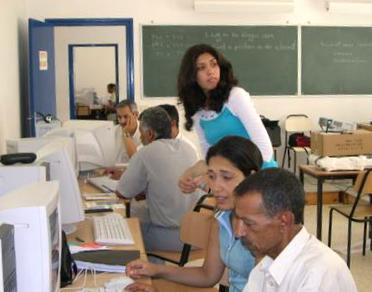 |
Two or three students had seemed very keen on getting pictures up
on the Internet. I started presenting the material linked from my blog (since
copied to the chart below). My instructional strategy was to
- Place the information online at my blog location and point out
to students where each item of information they would need was
- I expected that the participants would follow at least enough
to register where they could find the information later, as I presented it
- I intended that they would then work on the materials at their
own pace, and as questions as needed.
The information density was thick and required concentration.
During the presentation I was interrupted and it was suggested that I stop
there and have the students work on what I had presented in stepwise manner. I
preferred to complete the overview, but I had to take time out then and there
to defend myself from this challenge to my credentials (see expectations mismatch below) |
Here is what I presented, in my blog at the time, since
transferred here ...
I didn't get around to pointing out the following URLs, which were
not crucial to the lesson:
Software for meeting on online
http://www.homestead.com/prosites-vstevens/files/efi/software.htm
. This page discusses effective synchronous communication software, and
concerning the problems we'd had running Java enabled sites, as it was
downloadable, there is a Java troubleshooting guide here (at the time we were
still trying to resolve the problem with Tapped In) ...
- No Java? Get it here:
http://java.sun.com/getjava/index.html
- Once we got Java installed we could see effects, such as the
revolving panorama picture at
http://www.homestead.com/prosites-vstevens/files/vlrc/start.htm.
One of the participants wanted to know how that was done. Here's how:
- Standing in a central spot I took enough digital photos to cover
a 360 degree view of my surroundings
- I obtained software from http://www.pixaround.com
- I 'stitched' the pictures together using the software to make a
360 degree photo view. In stitching, the software blends the edge of one photo
with the edge of the next one over, giving you a continuous picture
effect.
- The software then displays the picture so that mouse movements
cause it to appear to rotate.
By the end of the day most participants (and I) had recovered from the
frustrations of the morning (see expectations mismatch
below). Many were on their way to putting pictures up at their sites (i.e.
blogs). I had taken a lot of pictures and was moving them from my camera to
Ofoto and then collecting them on my laptop where I cropped them and made other
enhancements in Thumbs Plus and then uploaded them to Homestead and
displayed them on my web pages.. Dalel seemed
interested in the potential for doing what I was showing them with video files
and we agreed to experiment. One of the students mentioned that she wanted to
know how to animate her images.
I later followed up on this:
- I took 2 videos Fri night, sized 2 meg and 2.5 megabytes
- Not sure what to do with this, really need something around 500
meg
- Might try to find a free conversion tool
Expectations Mismatch
During these workshops I frequently had to face challenges to my
instructional technique that interrupted my presentations and compromised my
ability to plan and implement my sessions as I saw fit. These challenges were
not without merit but were sometimes poorly timed.
- Participant expectation was that I would have broken down the
'lesson' in steps and presented it not as a set of activities linked from a web
page, with numerous hyperlinks exposing different depth of perspective on the
topic, but as a set of instructions. Some students expected that these
instructions would be on paper (where they could see it clearly), not embedded
in hyperlinked documents (infinitely more useful when working on the web, but
not compatible with these participants' accustomed way of working). It was
suggested that I should have had all the students working in tandem almost
keystroke by keystroke, so that each would master the material in lockstep.
- Such suggestions derived I thought from the participants not having
themselves taught using computers before, so they imagined that the lesson
would proceed as it would in a more easily controlled (but more constraining)
traditional class (on questioning the participants it developed that many DID
teach using computers, so I tried to point out that in my own computer labs
where we teach in this way we have the benefit of knowing the students, the
subject matter, and the educational setting such as network and software
available, and that we produce a syllabus and materials to support it as a team
effort that evolves over several teaching cycles) .
- It started to dawn on me that the participants were not using, did
not know how to use actually, the online environment I was setting up for them
with its potential for individual feedback and self-paced learning.
Actually, they were using it, and as the day progressed it
became apparent that the small coterie of 3 who seemed to be following my
lessons up to the mid-day break had expanded to at least half the participants
who just needed more time to overcome the lack of clear instructions (or more
correctly, misunderstanding about where to find the clear instructions). In
other words, they had been listening, and they were capable of finding the
information I had presented in my presentation, and with effort on their part,
they were able to find and follow up on my directions.
|
Friday July
23  |
Reflecting on feedback from the preceding day, I felt we needed to
have a discussion of online environments and how they are different from
classroom ones. In particular I wanted to get students thinking about
- the mismatch between their expectations
and the way I'd been presenting the material, conducting the class, and setting
up the educational structure.
- I wanted also to get students thinking beyond Saturday, when
the expert is no longer there, and whether they anticipated any further
interaction with each other and the trainers in the course.
|
We discussed the following chart, which I prepared off the top of my
head prior to class time:
| Characteristics of pedagogical
environments |
Face to face |
Online |
| presentation of material |
predictable order, linear |
hyperlinked, branching, non-linear |
| classroom management |
can be lockstep or project based |
self-paced |
| feedback from instructor |
Instructor responds 'on the fly', feedback ends when instructor
stops discourse, or students pursue suggestions in notes |
can be comprehensive and hyperlinked to further information if well
thought out in advance |
| most suitable learning paradigm |
any paradigm can be applied, but teachers tend to
dominate classrooms as 'sage on the stage' |
favor constructivist paradigms, teachers function best as 'guide on
the side' |
| Duration of learning |
stops at end of class |
continues beyond end of class with asynchronous modes of
communication possible, even synchronous ones |
| Demands on teacher |
takes place during class times and marking after class |
tends to be very demanding |
| Individualization |
suppressed |
conducive to individual effort |
| Interaction with students |
many slip through the cracks |
can be intensively one-on-one |
| Mode of presentation |
tends to be paper-based |
no paper, works via web pages |
| |
|
|
To pursue these characteristics and nurture the online environment, we
needed participation in the YahooGroup. Accordingly:
I asked students to revisit the Yahoo Groups
exercise from Tuesday. In particular I asked them to post an introduction
in the group messages. Up to that point there had only been three messages, two
from one participant and one from me. I was trying to get some interaction
going in the group, realizing that we had only two days left in the workshop,
and if this group didn't start interacting online, it probably never would.
Again, as I was trying to get students to respond to my suggestions,
I was interrupted and told that there had been complaints (from participants
present in the room) about my methods and that one of the organizers of the
teacher training sessions was 'angry'. I think the person interrupting me was
responding either to an email or phone call that had just been received and had
decided that the matter was urgent, but took that particular moment to start a
discussion with me, in front of the trainees, about the direction I had taken
the proceedings, which in the perception conveyed, was departing too far from
the Tunisian context. Whatever cooperation I was getting from the class at that
point was scattered and the class drifted aimlessly toward the break. No
participant from that group ever posted an introduction to the Yahoo
Group.
After the break I had meant to suggest how blogs can act as
hyperlinkable notepads that can be used with any Internet connection to record
in a replicable format what anyone learns or wishes to preserve from the
Internet, and how this can contribute toward a compilation of resources that
can be used in tutoring (such as addressing frequently asked questions). Toward
this end I had hoped to revive my activity planned for the
previous Tuesday, which was to get students looking at some of the links
from my websites, and record their findings in their blogs so that they could
be shared with the class.
After the challenges to my teaching over the past couple of days the
students did not seem inclined to follow my suggestions, though all worked
good-naturedly on their own projects during the afternoon, and I was resigning
myself to the situation I'd got myself into. Here are my reflections from this
afternoon.
- One group was conducting an examination of teaching resources, not
from my sites, but I asked them how they would be sharing that information with
others in the team. Locating resources is one aspect of the problem. The
challenge for the online tutor is to preserve the findings in such a way that
the tutor can retrieve them later and, more importantly, that they can be
shared with other tutors and turned into materials that students can use.
Ideally this needs to be done efficiently so that the tutor need only point
others to a web link in order to answer questions. I wasn't sure where the
information was being retained but this group told me that they were covering
that aspect.
- Other students were working on their blogs and I helped some with
resolving the mysteries of photo links in blogs.
- Another participant was very critical of how I was conducting the
class. She said she had nothing to do, and when I suggested she do the activity
I had set she said she had seen those sites and that she could explore them at
home and that she had expected more from opportunity to interact face to face
with an 'expert'. She and the others would have preferred the class to be
conducted more rigidly, at least with more obvious organization. She said the
knowledge I had 'given' them could have been imparted in half a day
essentially, and now several days later she was 'not satisfied'. I asked her to
make her points in an email to our Yahoo Groups list and she did, asking the
group if they felt they would use what they had learnt in their role as tutors.
I used her question in a poll I set on Yahoo Groups the next day.
- But by the end of this day I was becoming quite discouraged by the
reception I had received, and feeling a bit let down by the fact that others
had set up this meeting of these very intelligent and demanding teachers with a
foreign expert, but there was really nothing I could have done to prepare (had
I prepared extensive handouts based on assurances of robust Internet access, I
would have had to throw them out). As the person on the spot I was left holding
the bag essentially, and my discouragement over lack of cooperation with both
participants and organizers was making me wonder what I had to offer them. It
seemed to me to be a classic case of the students knowing more than the expert.
That is, they seemed to have a narrow perception of what it was I was supposed
to be helping them with and they knew better than I what I was supposed to be
teaching them and they couldn't tell me what it was exactly I was supposed to
be doing there but whatever I was doing, that wasn't what they wanted.
Before leaving I asked one or two of them if they had ever used
concordances and they didn't seem to be familiar with the concept so I decided
to do that on the following day.
|
Saturday July
24 - 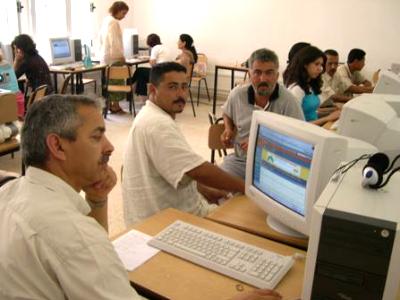 |
The morning (up to break time) was devoted to a project that Dalel
needed to have the trainees complete.
In the last two hours of our last day we went into my plan to look
at Concordancing as tutorial feedback, using the following program:
- Here is the concordance program site
http://www.edict.com.hk/concordance/.
If
starting here, select English / Simple Search
- The previous step brings you to the actual concordance page.
You can start directly here:
http://www.edict.com.hk/concordance/WWWConcappE.htm
- Here, set your parameters and conduct the concordance:
- set Search String equal to / starts with / ends with / or
contains (and enter the text to be concordanced)
- Select corpus (experiment here before using with
students)
- Sort on the words either to the left or to the right
|
LESSON FOR TODAY
Create a gap fill exercise where sets of blanks
must be filled in by the students.
First we need a short list of problem vocabulary. I started looking for
differences between 'greater' and 'bigger' as one of the participants had asked
me earlier which adjective would best collocate with 'enthusiasm'. I ran
concordances on 'great' and 'big' and we looked for classes of collocates to
the right, and then checked collocates to the left; for example 'even' bigger
and 'even' greater.
The words I had planned to use for the day (and whose concordances I had
run in advance so I knew ahead of time what the output would be,
were:
- in time
- on time
- fill in
- fill out
Next step was to run concordances on the words in question. At
http://www.edict.com.hk/concordance/WWWConcappE.htm
- FIRST - select an appropriate corpus
- When working with concordances as with any computer-based activity
you plan to use with students, it is important to preview the activity first.
- I had done this and determined that the corpus from The Times
newspaper TimesFeb95 has good examples of the items I am looking for.
- SECOND - sort left or right as needed; for example
- If comparing IN TIME with ON TIME sort left.
- If comparing FILL IN with FILL OUT sort right.
- THIRD - decide whether to set Search String equal to / starts with /
ends with / or contains
- For IN TIME and ON TIME set Search String to 'equal to'
- For FILL IN and FILL OUT set Search String to 'starts with'
This way you include FILLS, FILLING etc.
- FOURTH - Copy the examples you want to use to a Word document
- FIFTH - Select 3 or 4 descriptive contexts for each gap (where the
context is clearest and word choice is least ambiguous)
- SIXTH - Create your exercise (fill in instructions and format; for
example, paste boxes over words gapped)
Sources of text
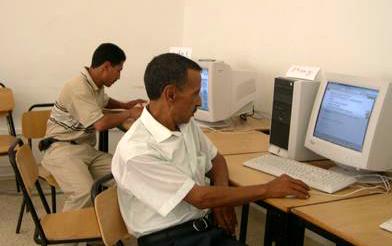 |
The online concordance site allows you to choose among a selection
of 'bodies' of text, known commonly as corpora. Some of the participants
suggested that the output for such texts may not contextualize well for their
students. I noted that I had in my own work used texts compiled from professors
who were writing text materials specifically for my students and used these as
my corpus, which I then concordanced to derive language learning materials. I
also noted that the truncated output strings 70 characters long proved to be an
advantage because I could prompt students to complete truncated words and
otherwise recall what might have come before or after each string in
question. |
I recommended as a source of texts the project Gutenberg site:
http://www.gutenberg.net/ . This site
aims to digitalize as many books as possible in several languages once their
copyright has expired. Texts are available for download free and their use is
unrestricted.
Buzznet
We then had a look at Buzznet, http://www.buzznet.com. I had started one
here http://mahdi2004.buzznet.com,
and I quickly showed the participants the interface and how to upload photos to
it. Within 15 minutes at least two participants had downloaded photos from our
shared album at
http://www.ofoto.com/BrowsePhotos.jsp?&collid=31747063206&page=1&sort_order=0
and uploaded them to their Buzznet blogs which they had just created:
If any other students have Buzznet blogs, please notify us via one of
our learning spaces (post a message at
http://groups.yahoo.com/group/mahdia_2004
for example).
Blogs are very good for getting your thoughts up for a class to see
quickly. It's better than using chalkboard because later you can copy your
notes elsewhere on your computer. Due to this ease of creation and use, and for
situations where a graphic interface is an asset, Buzznet appears to have some
advantages over Blogger.
Comparison of Buzznet and Blogger
| |
Blogger |
Buzznet |
|
Appearance of Blog |
Blogger allows much greater manipulation of appearance of the
overall blog, with changes possible to template and blog heading that give
users with knowledge of HTML and other web based tools great control over how
the blog will look. |
Buzznet presents a set interface (with advertisements) and does
not allow much alteration to appearance |
|
Organization of posts |
Blogger lists recent posts in the side-bar according to their
title, and as posts become old, they are 'archived' but not in a way they can
be easily retrieved. There are ways to improve retrieval but knowledge of HTML
and work with the template is required |
Buzznet associates each posting with a photo. Thumbnails of the
photos are arrayed and postings can be retrieved by clicking on the associated
thumbnail. As the cursor is passed over the thumbnail, the title of the posting
is displayed. Therefore it is possible to set up web spaces here which can be
organized by picture association. |
|
User Accounts |
With Blogger, you can create as many blogs as you like within one
user account. This is convenient from a management standpoint. Through one
logon you can manage many blog URLs. |
As far as I can tell, Buzznet allows you only one URL per account,
so to create multiple blogs, each has to have its own account. |
|
Upload of photos |
Blogger requires users to use <IMG SRC=""> and specify
location of URL of photo already on the Internet in order for pictures to
appear in blogs. I have noticed that there is mention of photo blogs in
recent versions of the interface but haven't had time to check this out
yet. |
Buzznet allows users to upload photos stored on their computers.
These are then stored on Buzznet's servers; no need to upload photos to spaces
where each has a URL |
|
Allowing comments from others |
Blogger requires that you initiate the invitation to others
to share comments in your blog. You provide that person's email address and
Blogger sends the invitee an email (this means you must know the email of the
person you want to share your blog with). The invitee can then respond and be
added as a member of your blog. The invitee needs to have a Blogger account and
is prompted to start one if this is not the case. When your invitation is
accepted, your blog appears in the list of blogs available to the invited
member, but the member can only post to, not edit, the blog.
The owner of the blog has complete control over editing and
deleting anyone's posting. People who post have no write permission to alter
anything they have posted. |
Buzznet is set up so that anyone can initiate a request to
comment on your blog. The only stipulation is that the user has to sign in to
Buzznet to do so. That means that the user has to start a Buzznet account, but
once signed in, the user can comment on your blog without your invitation.
Comments can appear in your blog from anywhere without your having to do any
setup.
Although users can write comments in your blog at will, the owner
of the blog has complete control over editing and deleting anyone's posting.
People who post have no write permission to alter anything they have
posted. |
|
Posting and editing posts |
Blogger has a clear system of changing numerous settings to the
blog. It offers many options but the existence of options can make it more
difficult to use. If users only post and edit posts, the interface will remain
simple, except that sometimes users get the HTML editor, and sometimes the
WYSIWYG editor, which can be confusing when it happens. Also saving a posting
(in a workspace) and publishing it (so others will see the change) are separate
steps. Users might save but not publish. Also any changes to the template or
settings require users to 'republish entire blog' which is also unclear to many
users. |
Buzznet has a clear system of changing postings, titles of posts,
and pictures associated with posts. The user has little control over other
features, such as the URL for the blog. However, the interface is consistent
for most operations. Clicking on the Save button publishes the blog, and there
are not settings or templates to be concerned with. |
|
Hyperlinking |
Sometimes users get the HTML editor, and sometimes the WYSIWYG
editor, which can be confusing when it happens. If the WYSIWYG editor appears
then there is a hyperlink tool which creates hyperlinks in a dialog box.
Otherwise users must manually input the code: <A HREF="html link goes
here">Text to click on goes here</A> |
Users must manually input the code: <A HREF="html link goes
here">Text to click on goes here</A> in order to create
hyperlinks in postings. |
|
Quirks |
Sometimes users get the HTML editor, and sometimes the WYSIWYG
editor, which can be confusing when it happens. I have not worked out how to
control whether this happens or not. Also Blogger servers can be busy and have
trouble synchronizing. You can edit a posting and publish it and not see the
changes when pulling up the posting to re-edit it. When that happens it's best
to call it a day and come back in the morning. I have also had problems seeing
archived posts in my students' blogs. |
Buzznet introduces extra line breaks between lines each time a
posting is edited and saved. These appear as <br /> tags in the posting
text. All but one of these needs to be removed each time the posting is saved,
or spaces between paragraphs will proliferate. Also some operations cause
errors (you have no right to alter this setting). When I get this message, the
change has usually been made to my blog, but it's disconcerting (and if you go
back into your posting to check, you have to remove the extra <br /> tags
as noted above. |
|
Backup!! |
There is no backup of your work on Blogger's servers. I advise
students to copy and paste to Notepad their existing template before making
changes to it (and save it to their hdd of course). Errors in the template can
make the blog invisible (but not disappear; the blog with all its postings is
there and will be restored with repair of template or selection of a new one).
Old templates can be retrieved from backup if one has been saved previously, or
you can change the template and restore changes you've made to it from the
copies you've made. Copies of the blog can be made by doing a file/save as in
your browser. You can also import your blog for hosting on another server. |
There is no backup of your work on Buzznet's servers. My own work
style is to keep copies of my Buzznet blogs in text documents on my hdd. I work
on the documents there and past them to the Edit postings area when ready to
publish. This technique keeps a copy on my computer and also ensures that there
is only one <br /> tag between each paragraph each time I publish. |
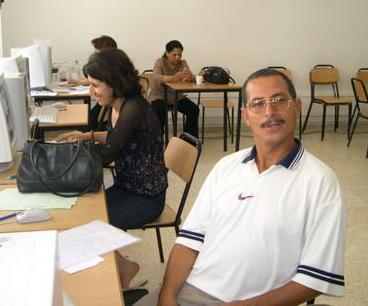 |
Screen captures
One participant suggested that I include a graphic of our photo
album in this web page. To do that I decided to bring the album up on the
screen and then do a screen capture. To do screen captures you
- Press the Im écran or Print Screen key;
this records the screen image to the computer memory buffer or 'clipboard'
- Use start / programs /accessories / Paint to open the Paint
program
- Paste the contents of the memory buffer or 'clipboard' to Paint
- Save the image as a JPG file if possible (some versions of
Paint force you to save as BMP or bitmap image)
|
In order to use the image you must manipulate it. For example, rarely
will you want to display the contents of the entire screen. You need a cropping
tool to select only the part you need. You might need to convert your huge BMP
image to a smaller (compressed) JPG or GIF. You might want to resize the image
or make other adjustments. Do this you'll need to trial or purchase image
editing software. You can find some shareware products listed here:
Online Survey Tools
A survey was created at Yahoo Groups for this course. Members of Yahoo
Groups can create surveys. Ours is here:
One disadvantage of YGroup surveys is you only can ask one question and
you can only poll your group members. If you want to create more comprehensive
surveys you can try:
This leads us to where you can
go for help in cases where you have any questions where you need tutoring in
your own professional development.
Questions such as 'Where can I find text manipulation software I can
download for free?' can be posted to numerous lists which I suggest
participants join. Some of these are:
See http://www.linguistic-funland.com/tesllist.html
for information on how to subscribe to NETEACH-L, TESLCA-L and other relevant
mailing lists.
In retrospect
I have really enjoyed working with this group of difficult and demanding
and challenging Tunisian students. I think we reached a point where we were
seeing eye to eye and intellect to intellect. I have accepted the critiques
made to my conduct of the workshop by its participants in a spirit of honest
and forthright feedback meant to help me improve my perception of the needs of
the trainees and their level of expectations from their trainers, and to thus
implement improvements for the second week. I hope the understandings reached
have been reciprocal, and that participants can see where impossible demands
have been placed, and where the guest expert has been striving to compensate
and adapt.
| |

Use the navigation at the top of this
page or your browser's BACK button to return to a previous page
For comments, suggestions, or further information
on this page
contact Vance Stevens, page webmaster.
Last Updated: July 30,
2004 |
Copyright 2004 by Vance Stevens











